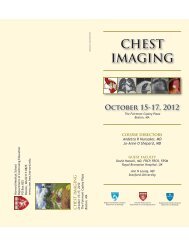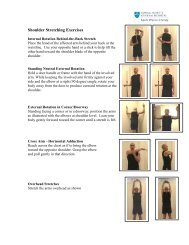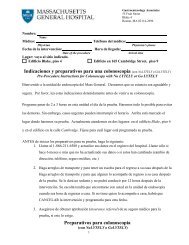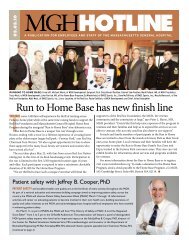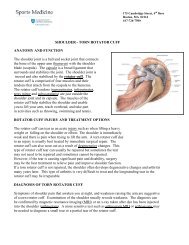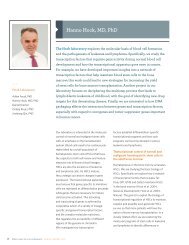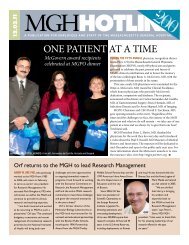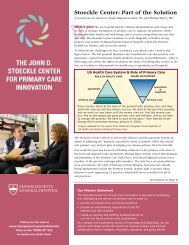Cyril Benes, PhD
Cyril Benes, PhD
Cyril Benes, PhD
You also want an ePaper? Increase the reach of your titles
YUMPU automatically turns print PDFs into web optimized ePapers that Google loves.
Network representation of genomic correlates shared by MEK1/2 and RAF inhibitors indentified by<br />
linear regression using drug sensitivity data across hundreds of cancer cell lines.<br />
Resistance to Cancer Therapies<br />
Even for the most successful anticancer<br />
therapies, drug resistance invariably emerges<br />
and limits the impact on patient lives. The<br />
molecular mechanisms underlying acquired<br />
resistance to cancer therapeutics are not well<br />
defined but are likely to be different for each<br />
therapy and cancer. We are investigating how<br />
drug combinations could overcome resistance,<br />
and within this context, studying how changes<br />
in intracellular signaling pathways affect drug<br />
response.<br />
We are tackling the problem of therapeutic<br />
resistance using cell lines made resistant in the<br />
laboratory or isolated from resistant tumors.<br />
Previous results have shown that these cell line<br />
models do recapitulate at least some of the<br />
mechanisms of resistance at play in patients.<br />
We interrogate combinations of a panel of<br />
clinically relevant anticancer drugs as a way to<br />
quickly identify candidate therapeutic strategies<br />
and to jumpstart mechanistic studies that<br />
will help characterize the molecular basis of<br />
acquired resistance.<br />
We are also approaching the problem<br />
of resistance using a very different and<br />
complementary approach. We systematically<br />
identify genes that can cause resistance<br />
to a given drug in a given context using a<br />
transposon-based genetic screen. Transposons<br />
are mobile genetic elements that can insert<br />
into a host genome—in our case, the genome<br />
of cancer cells. We use an engineered version<br />
of a transposon so we can control its mobility<br />
and identify genes with expressions that are<br />
modified by its insertion, leading to drug<br />
resistance.<br />
Selected Publications:<br />
Garnett MJ, Edelman EJ, Heidorn<br />
SJ, Greenman CD, Dastur A, Lau<br />
KW, Greninger P, Thompson IR, Luo<br />
X, Soares J, Liu Q, Iorio F, Milano<br />
RJ, Bignell GR, Tam AT, Davies H,<br />
Stevenson JA, Barthorpe S, Lutz SR,<br />
McLaren-Douglas A, Mitropoulos<br />
X, Mironenko T, Thi H, Richardson L,<br />
Zhou W, Jewitt F, Zhang T, O’Brien<br />
P, Price S, Hur W, Yang W, Deng X,<br />
Butler A, Choi HG, Chang JW, Baselga<br />
J, Stamenkovic I, Engelman JA,<br />
Sharma SV, Saez-Rodriguez J, Gray<br />
NS, Settleman J, Futreal PA, Haber<br />
DA, Stratton MR, Ramaswamy S,<br />
McDermott U, <strong>Benes</strong> CH. Systematic<br />
identification of drug sensitivity<br />
genomic markers in cancer cells.<br />
Nature. 483(7391):507-5, 2012, Mar 28.<br />
Singh A, Sweeney MF, Yu M, Burger<br />
A, Greninger P, <strong>Benes</strong> C, Haber<br />
D, Settleman J. TAK1 (MAP3K7)<br />
inhibition promotes apoptosis in<br />
KRAS-dependent colon cancers.<br />
Cell. 148(4):639-50, 2012 Feb 17.<br />
<strong>Benes</strong> CH, Poulogiannis G, Cantley<br />
LC, Soltoff SP. The SRC-associated<br />
protein CUB Domain-Containing<br />
Protein-1 regulates adhesion and<br />
motility. Oncogene. 2011 Jul 4.<br />
Katayama R, Khan TM, <strong>Benes</strong> C,<br />
Lifshits E, Ebi H, Rivera VM,<br />
Shakespeare WC, Iafrate AJ,<br />
Engelman JA, Shaw AT. Therapeutic<br />
strategies to overcome crizotinib<br />
resistance in non-small cell lung<br />
cancers harboring the fusion<br />
oncogene EML4-ALK. Proc Natl<br />
Acad Sci U S A. 108(18):7535-40,<br />
2011 May 3.<br />
Yuan TL, Choi HS, Matsui A, <strong>Benes</strong> C,<br />
Lifshits E, Luo J, Frangioni JV, Cantley<br />
LC. Class 1A PI3K regulates vessel<br />
integrity during development and tumorigenesis.<br />
Proc Natl Acad Sci U S A.<br />
105(28):9739-44, 2008 Jul 15.<br />
<strong>Benes</strong> CH, Wu N, Elia AE, Dharia T,<br />
Cantley LC, Soltoff SP. The C2 domain<br />
of PKCdelta is a phosphotyrosine<br />
binding domain. Cell. 121(2):271-80,<br />
2005 Apr 22.<br />
Principal Investigators<br />
7



